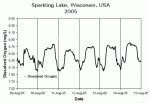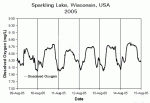Scientists at the North Temperate Lakes (NTL) LTER site have provided leadership in the emerging Global Lake Ecological Observatory Network (GLEON), an international, grassroots network of limnologists, ecologists, information technology experts, and engineers who have a common goal of building a scalable, persistent network of lake ecology observatories (Kratz et al. 2006, Hanson 2007). Data from these observatories will allow us to better understand key processes such as the effects of climate and land use change on lake function, the role of episodic events such as typhoons and storms in resetting lake dynamics, and carbon cycling within lakes.
The observatories will consist of instrumented platforms on lakes and reservoirs around the world capable of sensing key limnological variables and moving the data in near-real time to web-accessible databases. A common web portal will allow easy access to data by researchers and the public. A series of web services supported by this portal will allow computation of metrics-for example, estimates of rates of important processes such as gross primary production and respiration-based on the high frequency data.
The focus to date on the technology of sensor networks has caused data gathering capacity to leap ahead of the models and questions required to exploit these data. Ecological research is based on the inextricable links between observations, models, and questions (Figure 1). When any one node in the paradigm is pushed to a new time or space domain, the other two must follow. Sensor networks have pushed observations to a new domain in which high-frequency data are collected over extended spatial extents, requiring us to explore new ways of modeling ecosystems and challenging us to identify the most compelling scientific questions given these new data. To facilitate this development, we need to enhance discussion and transfer of ideas among ecologists and between ecologists and information technology experts. An example of observations that outstrip models and questions is the incomplete understanding of nighttime increases in dissolved oxygen concentration observed in lakes throughout the GLEON network (Figure 2). This phenomenon is currently unexplained, but is likely caused by either horizontal or vertical movement of higher oxygen concentration water past the sensor at night. This example of scientific discovery shows the promise of sensor networks to uncover previously unobserved phenomena.
Currently, Tim Kratz (NTL) is chair and Paul Hanson (NTL) is a member of the GLEON Steering Committee. Peter Arzberger, chair of the LTER Advisory Committee, also serves on the GLEON steering committee, while Barbara Benson (NTL), Evelyn Gaiser (FCE), and Sally McIntyre (SBC, ARC) also participate in the network. A related network, the Coral Reef Ecological Observatory Network (CREON), has similar goals and is being led by Sally Holbrook (MCR). The GLEON network has members in Argentina, Australia, Brazil, Canada, China, Finland, Israel, Japan, New Zealand, South Korea, Sweden, Taiwan, the United Kingdom, and the United States (Figure 3).
GLEON is supported by awards from the National Science Foundation, the Gordon and Betty Moore Foundation, and several domestic funding agencies within the participating countries.
References
Hanson, Paul C. 2007. A grassroots approach to sensor and science networks. Frontiers in Ecology and the Environment 5:343.
Kratz, Timothy K., Peter Arzberger, Barbara J. Benson, Chih-Yu Chiu, Kenneth Chiu, Longjiang Ding, Tony Fountain, David Hamilton, Paul C. Hanson, Yu Hen Hu, Fang-Pang Lin, Donald F. McMullen, Sameer Tilak, Chin Wu. 2006. Towards a Global Lake Ecological Observatory Network. Publications of the Karelian Institute 145:51-63.
Porter, J., Arzberger, P., Braun, H.W., Bryant, P., Gage, S., Hansen, T., Hanson, P., Lin, C.C., Lin, F.P., Kratz, T., Michener, W., Shapiro, S., and Williams, T. 2005. Wireless sensor networks for ecology. Bioscience 55: 561-572.

 Enlarge this image
Enlarge this image


